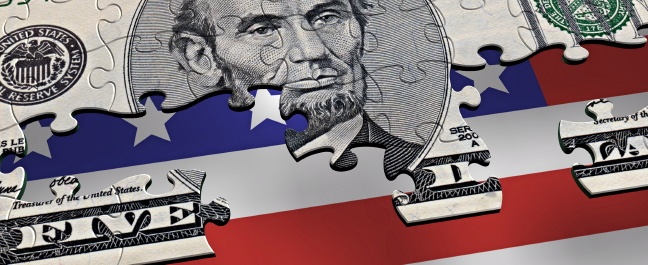Economist provides update on state, national economies, says Northwest Arkansas economy resilient
by May 23, 2017 4:30 pm 773 views

For all the uncertainty brewing nationally and globally, the Northwest Arkansas economy is at cruising altitude with no turbulence to speak of, according to Mervin Jebaraj, interim director for the Center for Business and Economic Research at the University of Arkansas.
Jebaraj spoke Tuesday (May 23) during the Quarterly Business Analysis Luncheon held in Fayetteville.
As to the uncertainty, there’s a lot riding nationally on promises of lower corporate taxes, repeal and replacement of the Affordable Care Act, and when and how the Federal Reserve will unwind more than $2.2 trillion from its balance sheet.
Jebaraj said there’s more going right in the local and state economies than wrong. The Northwest Arkansas economy is doing well. Nationally, the economy is in the third longest period of economic expansion at almost 96 months.
He said the nationwide Small Business Optimism Index remains high despite a slight pullback in April after the failed attempt to repeal and replace healthcare legislation. Also moving in the right direction is the National Home Builders/Wells Fargo Housing Market Index, which has been trending upward since 2014.
The Purchasing Managers Index reading, which measures manufacturing, has been above 55 for the past eight months, which is fair for a sector whose reading was below 50 in early 2016. The Bureau of Labor Statistics reports the statewide manufacturing segment grew 800 jobs in January, and 300 of those were in Northwest Arkansas. Jebaraj said this employment sector continues to shrink overall as technology is doing more of the work. He said statewide manufacturing still accounts for 12% of the jobs and it’s 11% of the jobs in Northwest Arkansas.
Consumers remain confident through April on the national scene with a sentiment reading close to 100. Jebaraj said that’s about as good as it gets and while sentiment is not quite as high as it was in 2016, it’s on par with levels in 2014. He said all the negative news and political posturing out of Washington is not yet impacting national economic performance.
NORTHWEST ARKANSAS GROWTH, CONCERNS
The local population is about 516,000 and Jebaraj said the labor force is growing at about 2% annually. He said people are moving in and finding jobs because the local unemployment rate is 2.5%, a bit higher than the 2% low mark hit in 1999. Statewide, the unemployment rate hit a record low of 3.5% in April as 19,700 new jobs were created in the state this year. Nationally, the unemployment rate stands at 4.4%.

Another area where Northwest Arkansas continues to shine is in per capita income which is $52,000, above the national rate of $49,000 and much better than the $39,000 statewide average. He said while unemployment remains low locally and statewide, there has not been an uptick in wages. The only plausible explanation is that there is still slack in the labor force, and an obvious mismatch of open jobs with available talent.
One troubled segment for the nation, state and region is retail. He said the country has shed 50,000 retail jobs this year, an unprecedented level historically. He said while retail is not a typically large employment sector for the state or region, it matters to how cities look and feel. He said with far too many department stores that more closures are coming and that could spell trouble for strip centers where they are located.
“Department stores often anchor retail space and with some of the biggest names in retail closing stores, it remains to be seen what will happen to the real estate they occupy. Our local cities have spent a lot of money on infrastructure in the shopping districts and as stores close, cities will have to work to keep these areas from blight,” he said.
Jeff Collins, former director of the Center for Business and Economic Research and an economic consultant for Talk Business & Politics, recently noted that sales tax revenue in the Northwest Arkansas economy closed out 2016 on a high note. Collections in Benton, Madison and Washington counties totaled $9.293 million in December, better than the $8.649 million in December 2015, according to Collins’ notes for The Compass Report. Tax revenue growth in the region is even more impressive when compared with the larger central Arkansas metro.
“The Northwest Arkansas regional economy had sales and use tax collections totaling roughly $25.8 million in the quarter while the Central Arkansas regional economy had collections for the same period of roughly $27.5 million,” Collins noted.
Economic conditions in four Arkansas metro areas were mixed in the final quarter of 2016, with the Northwest Arkansas and Fort Smith metros ending the year on a positive note relative to the third quarter, according to The Compass Report. Compared to the third quarter of the year, Central Arkansas and the Jonesboro metro showed slight declines. Compared to the fourth quarter of 2015, the pace of economic growth was down slightly in Central Arkansas and in Northwest Arkansas, up in the Fort Smith metro, and slightly better in the Jonesboro metro.
Collins said a long-term risk for the Northwest Arkansas economy – and even so for the state economy – is the level of success Wal-Mart Stores reaches in meeting retail challenges.
“Of all of the sectors of the economy, none has been more dynamic than retail in the past decade. Recent lay-offs at Wal-Mart corporate in Northwest Arkansas clearly underscore the challenges faced by traditional retailers seeking to compete in an increasing online marketplace,” Collins said.
He noted that what should have everyone’s attention in Arkansas is that Amazon has a market cap of $449 billion compared to Wal-Mart’s $232 billion.
“As Wal-Mart seeks to improve its ability to compete, local leaders are anything but disinterested spectators. Whether or not Wal-Mart will be successful remains to be seen but the need to continue the diversification of the regional economy is not at issue. The greatest risk is believing that past success implies future success. This is clearly not the case, as anyone from a metro area built on manufacturing can attest,” Collins said.
STUDENT DEBT, NATIONAL ECONOMY OUTLOOK
Household debt is also a concern as it surpassed $12.73 trillion earlier this year. Jebaraj said at the start of the recession in 2008 household debt was $12.68 trillion, but one major difference between then and now is the amount of debt associated with home ownership. He said there is no evidence now that shows home owners are oversold on their homes. The areas of concern are auto loans and student loan debt as each are seeing higher than normal 90-day delinquencies. He said student loan debt stands at $1.3 trillion and 11% of borrowers are more than 90 days past due.
One area impacted from higher consumer and student loan debt is homeownership rates. He said most of the age brackets are showing declining homeownership, except for those age 65 and up. With high student loan balances, millennials who might want to own a home are likely making the equivalent of two car payments which can hurt their ability to save for a downpayment, he said.
Jebaraj said the 2.5% expected national growth rate for the remainder of the year is predicated on the assumption that small and large businesses will benefit from corporate tax reform, if healthcare legislation is passed, and if there is some infrastructure investment announcement for early next year.
He also is eager to see how the Federal Reserve decides to unwind its holdings of mortgage-backed securities on its balance sheet to the tune of $2.2 trillion. Jebaraj said if they raise interest rates in June and September by .25% each time, they will likely wait until 2018 to begin reductions in balance sheet holdings as they try to keep inflation in check. Inflation is about 2% and that’s where the Fed would like to see it stay.
Jebaraj said if any of the underlying presumptions are missed then there could be some turbulence to the national economy with fallout at the state and local levels as well.
Collins said GDP growth will continue to depend on consumer willingness to spend.
“It remains to be seen if business investment will accelerate or continue to show mixed results. Analysts expect fiscal stimulus in the form of increased spending and tax cuts but the impact of both is at least a year out, assuming they occur at all,” Collins noted.
Talk Business & Politics Executive Editor Michael Tilley contributed to this report.
